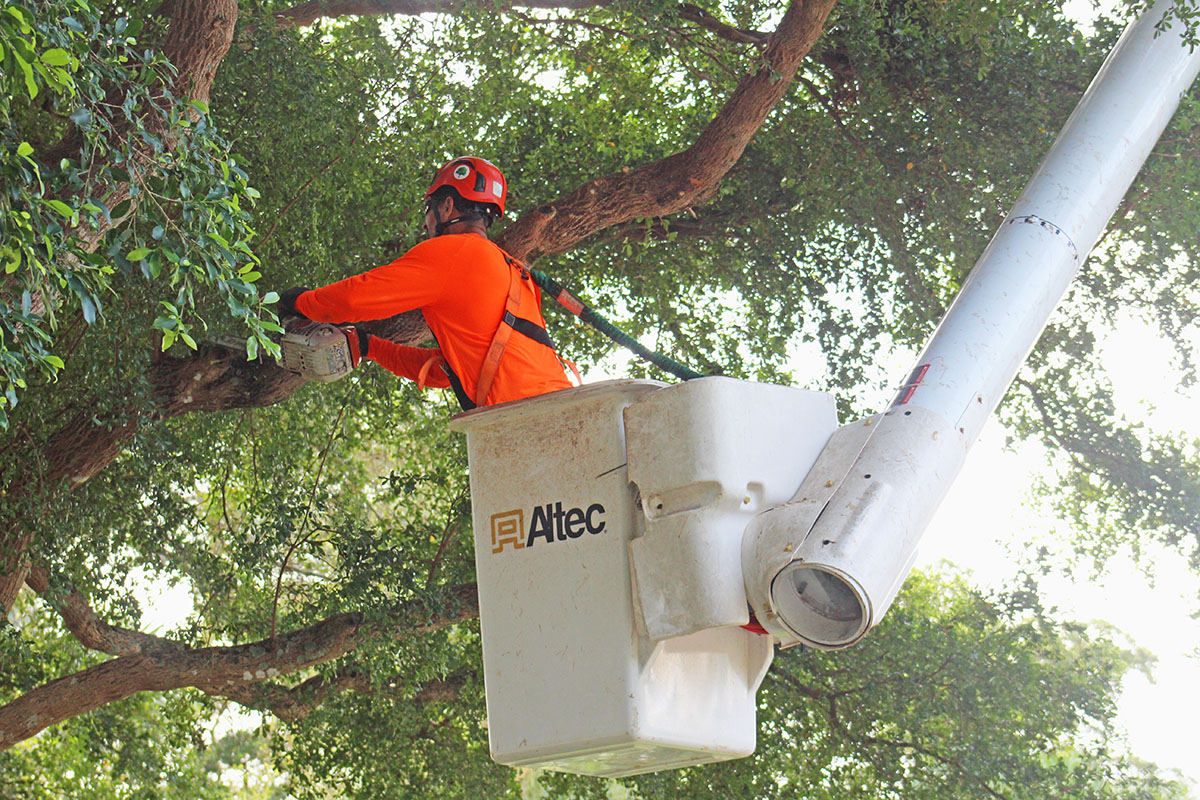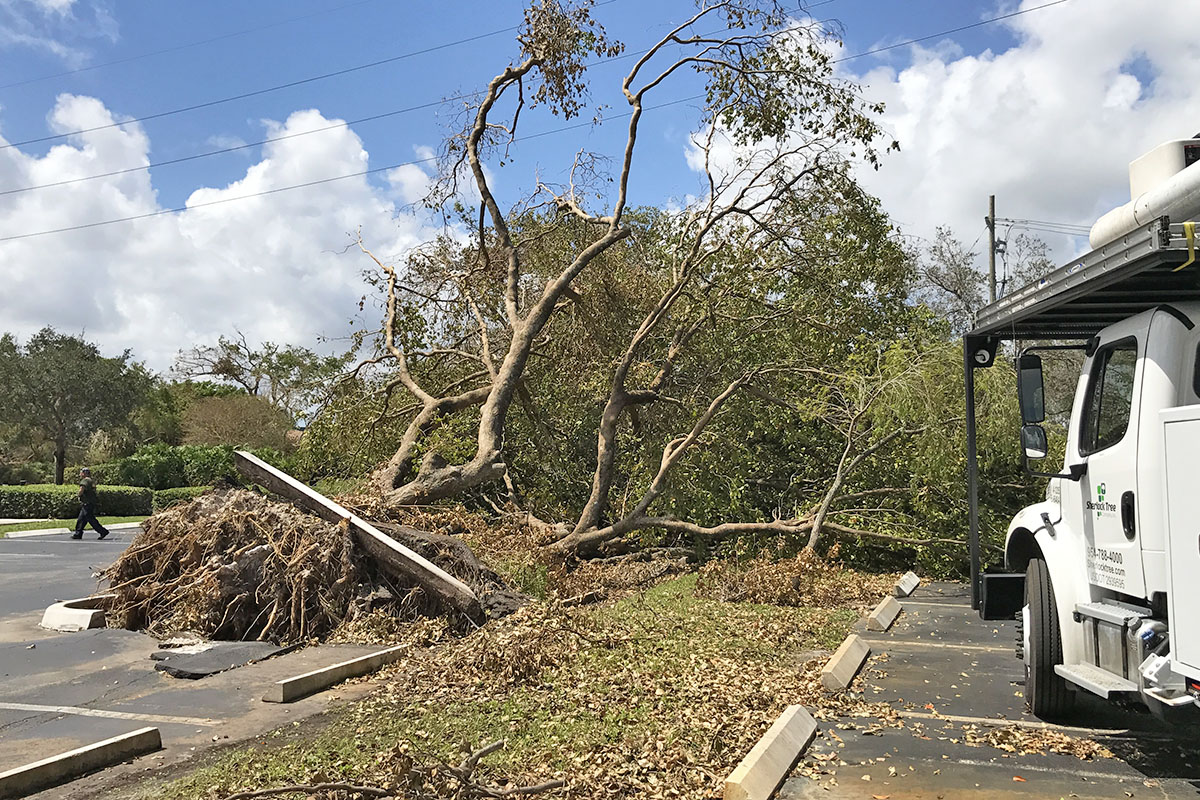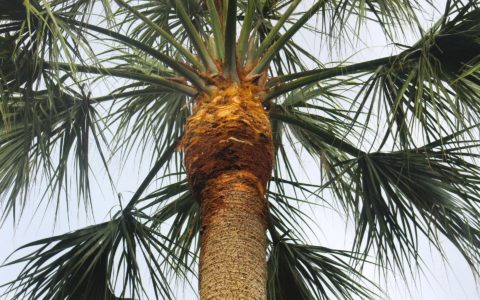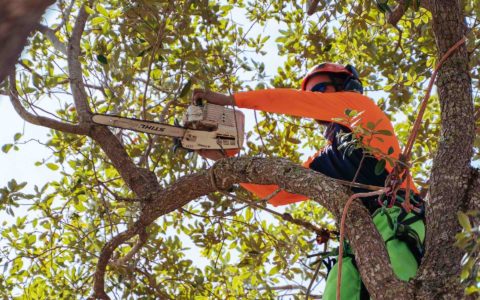Although there’s no such thing as completely preventing damage in the most powerful of hurricanes (category 4 or 5), there is a way to minimize hurricane damage caused by trees. By taking some preventive measures before the arrival of tropical storms and the more common category 1-3 hurricanes that we experience here in south Florida, you can avoid the worst of the potential damage.
Unlike the last-minute notice we may receive that a hurricane is on its way, these are things that you can implement long before the wind and rain picks up and the sky gets dark.
Hurricane Damage
Most of us have seen what kind of chaos can ensue from a hurricane. Downed power lines, branches through windows, uprooted trees and worse. Strong winds are to blame for most of the damage, but rain can be an added stressor, causing flooding and loosening of the soil, especially around tree roots. The end result is trees being toppled by winds as the roots are pulled out of the ground.
This is even more applicable for recently planted trees that haven’t yet developed a large root system to stabilize them during unpredictable wind gusts.
Storms and hurricanes also cause broken branches and even snapped tree trunks, making the trees dangerous to be around after the storm has passed. Broken branches, in particular, can fall without warning, severely injuring a person or damaging a structure below.
And don’t forget the damage done to nearby buildings, wires/cables, and satellite dishes from branches that fly about.
Removing all Trees is Not the Answer
You might be tempted to remove trees to minimize damage, but as various storms have hit, we’ve seen that neighborhoods with the most tree cover actually have the least amount of damage and debris. The secret is to have healthy, deeply rooted, well-maintained trees.
You can also lower the risk of tree damage from hurricanes by choosing hurricane-resistant trees, carefully choosing their location, and planting them properly. Here’s our list of the most hurricane-resistant trees to plant in south Florida, as well as tips for where and how to plant them.
What You Can Do
There are ways that you can help minimize the risk of damage and protect yourself and your property. Take some time to examine your trees (from the ground – don’t try to climb them!) and see if you spot any of the following issues, which increase the risk of damage from hurricanes and tropical storms. Then contact a Certified Arborist to address these risks and take proper action – such as pruning or improving the health of your trees – before any major storms come through.
If you don’t have the time or the inclination to check for these issues with your trees, contact us for a tree and property inspection. The Certified Arborists at Sherlock Tree Company are trained to look for potential hazards posed by your trees.
However, if you do have a moment, look for:
- Dead or damaged branches and/or trees. Look for deadwood, cracks or splits, hanging branches, or any other sort of damage. These are more likely to snap when under pressure from high winds.
- Diseased or decayed wood. Trees and branches that aren’t healthy are generally weaker and more vulnerable to breakage.
- Structural problems. While a Certified Arborist is best able to identify structural problems that compromise the stability of a tree, there are some things you can see yourself. Look for V-shaped crotches, crossing branches that are rubbing against each other, and top-heavy trees (where the canopy has been excessively “lifted” to provide more clearance underneath).
- Severely leaning trees. Just because a tree is leaning doesn’t mean that it will fall over. But the more it leans, the greater the risk of failure, especially when rains have saturated the ground.
- Poor root structure. A tree that’s not firmly anchored is more susceptible to failure during a storm. Things to look out for include girdling roots, cut or damaged roots (such as from nearby construction), and newly planted trees with little root growth.
- Topped trees. We do not top trees because new growth is poorly attached and susceptible to breakage (among other problems). If a tree has previously been topped, it should be inspected for potential safety issues.
- Lion-tailed trees. This is another pruning method we don’t employ because of health and safety implications for the tree. During a storm, the heavy foliage growth at the end of the long, bare branches gets whipped around, breaking the branches.
- Overly dense canopy. A tree with a thick canopy of leaves acts as a sail, rather than letting wind pass through. The addition of moss adds to this, so special attention is needed for trees like live oaks that contain Spanish moss.
- Improperly pruned trees. Some trees are mistakenly “thinned” by removing a lot of branches from the interior of the tree, while leaving plenty of foliage around the outside. Unfortunately, this misguided technique makes storm damage more likely.

Proper pruning to prevent hurricane damage can only be done up close and personal – often, that means using a bucket truck to raise the arborist into the tree
Take Action Now
Although hurricane season here is officially June 1 through November, 30, the majority of severe storms usually hit starting in September or October, which means you have time to take preventive action.
- Properly pruning mature trees, especially those with Spanish moss like live oaks, ensures that wind can blow through the tree’s canopy. When a tree has not been maintained or pruned properly, the wind blows against the tree instead of through it, causing it to bend or snap. Along with the heavy rains, large branches are prone to break during storms and the whole tree can be toppled. We can use a pruning technique called crown thinning to address this. It reduces the overall weight of the tree canopy and increases airflow through the branches.
- If you notice crossing branches, dead, damaged or diseased wood, or overhanging branches, we can also use corrective pruning methods.
- If you have a tree that has been transplanted or newly planted recently, properly staking it will give it extra support.
- Trees may need the assistance of cabling and bracing to support some branches and keep them together during storms.
- Some trees, however, may be beyond repair, in which case we recommend tree removal. If a tree is already dead, be sure to remove it as quickly as possible, as it is almost guaranteed to fall during the next storm.
- We also provide storm clean up services (prioritizing existing clients) for any downed or damaged trees or branches.
Be Prepared
Trees are part of our history and should be part of our future. They have the capability to withstand powerful winds and rains, but only if they’ve been given proper care.
Before hurricane season gets into full swing, consider the benefits of preventive pruning. Regular tree maintenance and pruning by a Certified Arborist is the best way to keep your trees healthy and minimize the risk of hurricane damage. Investing in these services now can save you a lot of time, energy, and money in the future.
Call Sherlock for quality tree services
Whether you're looking for specific tree care services, such as palm trimming, tree removal, or disease treatments, or would like one of our Arborists to examine your trees to identify any issues and recommend options, we're always here for you! Just give us a call at 954-788-4000 to set up an appointment.
SEE MORE ARTICLES
Looking for more?
We've got you covered with a monthly newsletter full of tips, resources, updates, how-to's, and other helpful information about trees and landscapes in South Florida!




